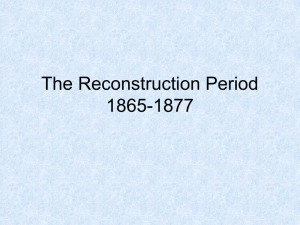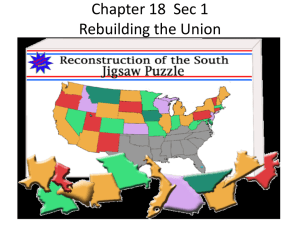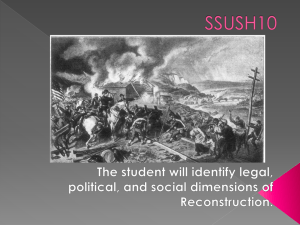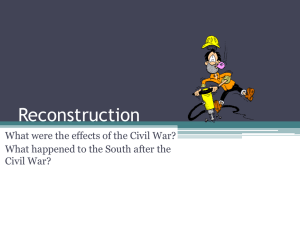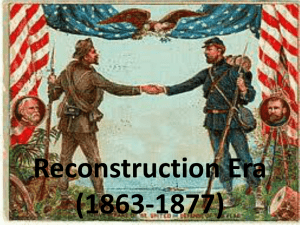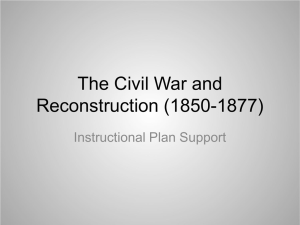Term 2 test Question Review
advertisement
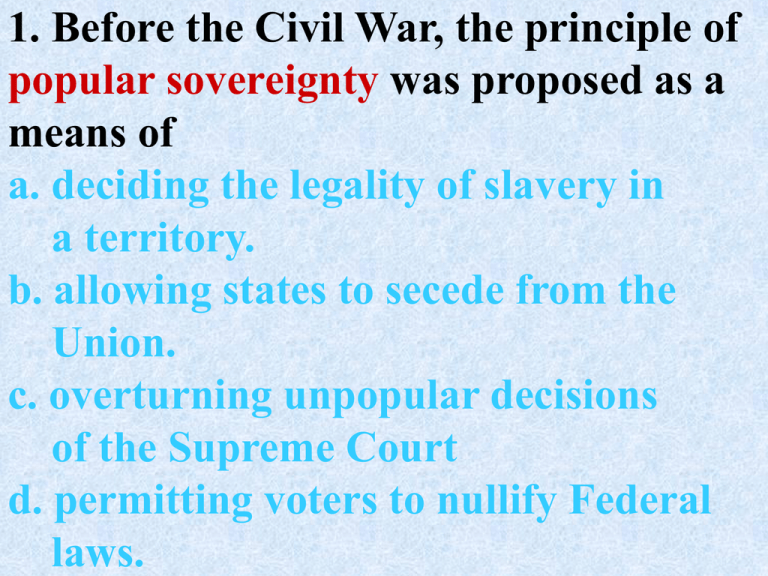
1. Before the Civil War, the principle of popular sovereignty was proposed as a means of a. deciding the legality of slavery in a territory. b. allowing states to secede from the Union. c. overturning unpopular decisions of the Supreme Court d. permitting voters to nullify Federal laws. 1. Before the Civil War, the principle of popular sovereignty was proposed as a means of a. deciding the legality of slavery in a territory. b. allowing states to secede from the Union. c. overturning unpopular decisions of the Supreme Court d. permitting voters to nullify Federal laws. 1. Before the Civil War, the principle of popular sovereignty was proposed as a means of a. deciding the legality of slavery in a territory. b. allowing states to secede from the Union. c. overturning unpopular decisions of the Supreme Court d. permitting voters to nullify Federal laws. 2. The fourteenth amendment is important because, in addition to awarding citizenship to former slaves, it a. provides protection against illegal search and seizure b. guarantees women the right to vote. c. abolished the poll tax. d. guarantees equal protection under the law. 2. The fourteenth amendment is important because, in addition to awarding citizenship to former slaves, it a. provides protection against illegal search and seizure b. guarantees women the right to vote. c. abolished the poll tax. d. guarantees equal protection under the law. 2. The fourteenth amendment is important because, in addition to awarding citizenship to former slaves, it a. provides protection against illegal search and seizure b. guarantees women the right to vote. c. abolished the poll tax. d. guarantees equal protection under the law. 3. The book A Century of Dishonor attempted to inform the public about the problems of a. Native Americans b. Asian Americans c. Mexican Americans d. Vietnam veterans 3. The book A Century of Dishonor attempted to inform the public about the problems of a. Native Americans b. Asian Americans c. Mexican Americans d. Vietnam veterans 3. The book A Century of Dishonor attempted to inform the public about the problems of a. Native Americans b. Asian Americans c. Mexican Americans d. Vietnam veterans 4. A major purpose of the Emancipation Proclamation was to a. provide for new state governments b. end Jim Crow laws in the South c. help the North win the Civil War d. give land to freedmen 4. A major purpose of the Emancipation Proclamation was to a. provide for new state governments b. end Jim Crow laws in the South c. help the North win the Civil War d. give land to freedmen 4. A major purpose of the Emancipation Proclamation was to a. provide for new state governments b. end Jim Crow laws in the South c. help the North win the Civil War d. give land to freedmen 5. After the Civil War, serious differences between Congress and Andrew Johnson about how to handle Reconstruction led to the a. impeachment of President Johnson b. resignation of President Johnson c. end of the Ku Klux Klan d. election of a Democratic President 5. After the Civil War, serious differences between Congress and Andrew Johnson about how to handle Reconstruction led to the a. impeachment of President Johnson b. resignation of President Johnson c. end of the Ku Klux Klan d. election of a Democratic President 5. After the Civil War, serious differences between Congress and Andrew Johnson about how to handle Reconstruction led to the a. impeachment of President Johnson b. resignation of President Johnson c. end of the Ku Klux Klan d. election of a Democratic President 6. As a strict constructionist, President Thomas Jefferson questioned the constitutional right to a. purchase the Louisiana Territory b. receive diplomats from foreign nations c. veto legislation passed by Congress d. grant pardons to convicted criminals 6. As a strict constructionist, President Thomas Jefferson questioned the constitutional right to a. purchase the Louisiana Territory b. receive diplomats from foreign nations c. veto legislation passed by Congress d. grant pardons to convicted criminals 6. As a strict constructionist, President Thomas Jefferson questioned the constitutional right to a. purchase the Louisiana Territory b. receive diplomats from foreign nations c. veto legislation passed by Congress d. grant pardons to convicted criminals 7. Early in his Presidency, Abraham Lincoln declared his goal as President was to a. encourage sectionalism b. enforce the Emancipation Proclamation c. end slavery throughout the entire country d. preserve the Union 7. Early in his Presidency, Abraham Lincoln declared his goal as President was to a. encourage sectionalism b. enforce the Emancipation Proclamation c. end slavery throughout the entire country d. preserve the Union 7. Early in his Presidency, Abraham Lincoln declared his goal as President was to a. encourage sectionalism b. enforce the Emancipation Proclamation c. end slavery throughout the entire country d. preserve the Union 8. Which newspaper headline best illustrates the principle of checks and balances? a. “U.S. Warships Sent to Persian Gulf” b. “Federal Aid to Cities Cut 10%” c. Congress Overrides Presidential veto.” d. “State Must Mandate 55 MPH Speed Limit” 8. Which newspaper headline best illustrates the principle of checks and balances? a. “U.S. Warships Sent to Persian Gulf” b. “Federal Aid to Cities Cut 10%” c. Congress Overrides Presidential veto.” d. “State Must Mandate 55 MPH Speed Limit” 8. Which newspaper headline best illustrates the principle of checks and balances? a. “U.S. Warships Sent to Persian Gulf” b. “Federal Aid to Cities Cut 10%” c. Congress Overrides Presidential veto.” d. “State Must Mandate 55 MPH Speed Limit” 9. What was the aim of the Dawes Act of 1887? a. To maintain traditional Native American culture b. to end all governmental contact with Native Americans c. to assimilate Native Americans into American culture d. to restore previously taken land to Native Americans. 9. What was the aim of the Dawes Act of 1887? a. To maintain traditional Native American culture b. to end all governmental contact with Native Americans c. to assimilate Native Americans into American culture d. to restore previously taken land to Native Americans. 9. What was the aim of the Dawes Act of 1887? a. To maintain traditional Native American culture b. to end all governmental contact with Native Americans c. to assimilate Native Americans into American culture d. to restore previously taken land to Native Americans. 10. A major reason for the issuance of the Monroe Doctrine was to a. prevent further European colonization in the Caribbean b. provide economic aid to Latin American nations c. defend the Panama Canal d. discourage U.S. trade with Latin America. 10. A major reason for the issuance of the Monroe Doctrine was to a. prevent further European colonization in the Caribbean b. provide economic aid to Latin American nations c. defend the Panama Canal d. discourage U.S. trade with Latin America. 10. A major reason for the issuance of the Monroe Doctrine was to a. prevent further European colonization in the Caribbean b. provide economic aid to Latin American nations c. defend the Panama Canal d. discourage U.S. trade with Latin America. 11. What was the result of the Supreme Court decisions made under Chief Justice John Marshall a. Anti-trust laws were upheld b. The system of slavery was weakened c. The federal government was strengthened d. The rights of workers were supported 11. What was the result of the Supreme Court decisions made under Chief Justice John Marshall a. Anti-trust laws were upheld b. The system of slavery was weakened c. The federal government was strengthened d. The rights of workers were supported 11. What was the result of the Supreme Court decisions made under Chief Justice John Marshall a. Anti-trust laws were upheld b. The system of slavery was weakened c. The federal government was strengthened d. The rights of workers were supported 12. What effect did the Louisiana Purchase have on the U.S.? a. It created an alliance between the U.S. and Great Britain b. It brought Texas into the Union. c. It doubled the size of the nation. d. It enabled the U.S. to use the port of San Francisco. 12. What effect did the Louisiana Purchase have on the U.S.? a. It created an alliance between the U.S. and Great Britain b. It brought Texas into the Union. c. It doubled the size of the nation. d. It enabled the U.S. to use the port of San Francisco. 12. What effect did the Louisiana Purchase have on the U.S.? a. It created an alliance between the U.S. and Great Britain b. It brought Texas into the Union. c. It doubled the size of the nation. d. It enabled the U.S. to use the port of San Francisco. 13. The most long-lasting victory for civil rights achieved during Reconstruction was the a. ratification of the 13th, 14th and 15th Amendments b. passage of Black Codes throughout the South. c. establishment of a strong two-party political system in the South. d. increased prominence given to the Office of the President. 13. The most long-lasting victory for civil rights achieved during Reconstruction was the a. ratification of the 13th, 14th and 15th Amendments b. passage of Black Codes throughout the South. c. establishment of a strong two-party political system in the South. d. increased prominence given to the Office of the President. 13. The most long-lasting victory for civil rights achieved during Reconstruction was the a. ratification of the 13th, 14th and 15th Amendments b. passage of Black Codes throughout the South. c. establishment of a strong two-party political system in the South. d. increased prominence given to the Office of the President. 14. The major goal of the civil rights movement of the 1960’s was to a. permit unlimited immigration to the U.S. b. end segregation based on race. c. gain passage of an equal rights amendment to the Constitution. d. established a separate political state for African Americans. 14. The major goal of the civil rights movement of the 1960’s was to a. permit unlimited immigration to the U.S. b. end segregation based on race. c. gain passage of an equal rights amendment to the Constitution. d. established a separate political state for African Americans. 14. The major goal of the civil rights movement of the 1960’s was to a. permit unlimited immigration to the U.S. b. end segregation based on race. c. gain passage of an equal rights amendment to the Constitution. d. established a separate political state for African Americans. 15. After the Civil War, the poll tax, literacy test, and grandfather clause were used to ensure that a. poor people were given equal voting rights. b. the elderly in the South could vote. c. all citizens exercised the right to vote. d. the voting rights of most former slaves were denied. 15. After the Civil War, the poll tax, literacy test, and grandfather clause were used to ensure that a. poor people were given equal voting rights. b. the elderly in the South could vote. c. all citizens exercised the right to vote. d. the voting rights of most former slaves were denied. 15. After the Civil War, the poll tax, literacy test, and grandfather clause were used to ensure that a. poor people were given equal voting rights. b. the elderly in the South could vote. c. all citizens exercised the right to vote. d. the voting rights of most former slaves were denied. 16. Which historic period was marked by the military occupation of a portion of the U.S., attempts to remove the President from office, and major constitutional revisions? a. Vietnam War era b. Depression and the New Deal c. Reconstruction d. Roaring Twenties 16. Which historic period was marked by the military occupation of a portion of the U.S., attempts to remove the President from office, and major constitutional revisions? a. Vietnam War era b. Depression and the New Deal c. Reconstruction d. Roaring Twenties 16. Which historic period was marked by the military occupation of a portion of the U.S., attempts to remove the President from office, and major constitutional revisions? a. Vietnam War era b. Depression and the New Deal c. Reconstruction d. Roaring Twenties 17. Which term is most closely related to the U.S. concept of Manifest Destiny? a. expansionism b. internationalism c. neutrality d. collective security 17. Which term is most closely related to the U.S. concept of Manifest Destiny? a. expansionism b. internationalism c. neutrality d. collective security 17. Which term is most closely related to the U.S. concept of Manifest Destiny? a. expansionism b. internationalism c. neutrality d. collective security 18. The passage of the Homestead Act and the completion of the transcontinental railroad helped to fulfill the U.S. commitment to a. racial equality b. manifest destiny c. conservation of natural resources d. Reconstruction 18. The passage of the Homestead Act and the completion of the transcontinental railroad helped to fulfill the U.S. commitment to a. racial equality b. manifest destiny c. conservation of natural resources d. Reconstruction 18. The passage of the Homestead Act and the completion of the transcontinental railroad helped to fulfill the U.S. commitment to a. racial equality b. manifest destiny c. conservation of natural resources d. Reconstruction 19. “Lincoln suspends Habeas Corpus” “FDR Supports Relocation of Japanese Americans” Which is a valid conclusion based on these headlines? a. The status of minority groups often improves during wartime. b. Great Presidents seldom take controversial actions. c. Restrictions on people’s rights may occur during wartime. 19. “Lincoln suspends Habeas Corpus” “FDR Supports Relocation of Japanese Americans” Which is a valid conclusion based on these headlines? a. The status of minority groups often improves during wartime. b. Great Presidents seldom take controversial actions. c. Restrictions on people’s rights may occur during wartime. 19. “Lincoln suspends Habeas Corpus” “FDR Supports Relocation of Japanese Americans” Which is a valid conclusion based on these headlines? a. The status of minority groups often improves during wartime. b. Great Presidents seldom take controversial actions. c. Restrictions on people’s rights may occur during wartime. 20. Which Principle is illustrated by the passage of the Sedition Act of 1798, the suspension of habeas corpus in 1861, and the adoption of the Espionage Act in 1917? a. National interest is sometimes given priority over individual rights. b. Congress expands its other powers when it declares war. c. National crises often result in restriction of the Supreme Court. 20. Which Principle is illustrated by the passage of the Sedition Act of 1798, the suspension of habeas corpus in 1861, and the adoption of the Espionage Act in 1917? a. National interest is sometimes given priority over individual rights. b. Congress expands its other powers when it declares war. c. National crises often result in restriction of the Supreme Court. 20. Which Principle is illustrated by the passage of the Sedition Act of 1798, the suspension of habeas corpus in 1861, and the adoption of the Espionage Act in 1917? a. National interest is sometimes given priority over individual rights. b. Congress expands its other powers when it declares war. c. National crises often result in restriction of the Supreme Court. The End
